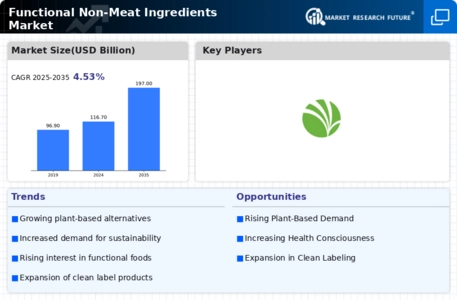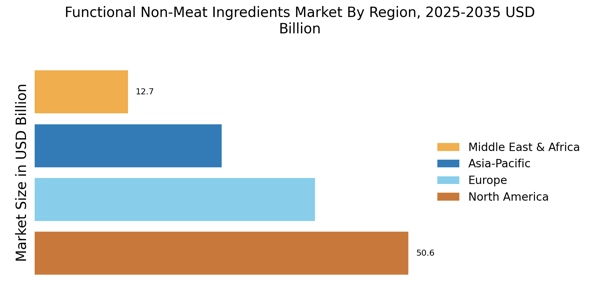Innovation in Food Technology
Advancements in food technology are significantly influencing the Functional Non-Meat Ingredients Market. Innovations such as fermentation, extrusion, and encapsulation are enabling the development of new ingredients that enhance flavor, texture, and nutritional value without relying on meat. For instance, the introduction of mycelium-based products and other novel protein sources has opened new avenues for product development. Market data suggests that the food technology sector is expected to grow at a compound annual growth rate of around 8% over the next five years. This growth is likely to drive the demand for functional non-meat ingredients, as manufacturers seek to create more appealing and versatile products that align with evolving consumer preferences.
Health Consciousness Among Consumers
The increasing awareness of health and wellness among consumers appears to be a primary driver for the Functional Non-Meat Ingredients Market. As individuals become more informed about the nutritional benefits of various ingredients, there is a noticeable shift towards products that offer functional benefits, such as improved digestion and enhanced immunity. According to recent data, the demand for plant-based proteins and functional ingredients has surged, with a projected growth rate of approximately 10% annually. This trend indicates that consumers are actively seeking alternatives that not only meet their dietary preferences but also contribute positively to their overall health. Consequently, manufacturers are responding by innovating and expanding their product lines to include a variety of functional non-meat ingredients that cater to this health-conscious demographic.
Culinary Trends Favoring Plant-Based Diets
Culinary trends that favor plant-based diets are emerging as a significant driver for the Functional Non-Meat Ingredients Market. Chefs and food influencers are increasingly promoting plant-based dishes, which has led to a surge in interest among consumers. This trend is not merely a passing fad; it appears to be reshaping menus across restaurants and food service establishments. Data suggests that the plant-based food market is expected to grow by 11% annually, indicating a robust shift in consumer preferences. As culinary innovation continues to thrive, the demand for functional non-meat ingredients that enhance flavor and texture in plant-based dishes is likely to increase, further propelling the market forward.
Rising Demand for Sustainable Food Sources
The growing concern for sustainability and environmental impact is driving the Functional Non-Meat Ingredients Market. Consumers are increasingly prioritizing products that are not only healthy but also environmentally friendly. This shift is reflected in the rising demand for plant-based ingredients, which are perceived as more sustainable compared to traditional meat sources. Market analysis indicates that the plant-based food sector is projected to reach a valuation of over 74 billion by 2027, highlighting the potential for functional non-meat ingredients to play a pivotal role in this transition. As consumers seek to reduce their carbon footprint, manufacturers are likely to respond by incorporating more sustainable practices and ingredients into their offerings.
Regulatory Support for Alternative Proteins
Regulatory frameworks that support the development and commercialization of alternative proteins are emerging as a crucial driver for the Functional Non-Meat Ingredients Market. Governments are increasingly recognizing the need for sustainable food sources and are implementing policies that encourage innovation in plant-based and alternative protein sectors. For example, certain regions have introduced subsidies and grants for companies focusing on sustainable ingredient development. This regulatory support is likely to foster a more favorable environment for the growth of functional non-meat ingredients, as it encourages investment and research in this area. As a result, the market may witness an influx of new products that meet both consumer demand and regulatory standards.



















Leave a Comment